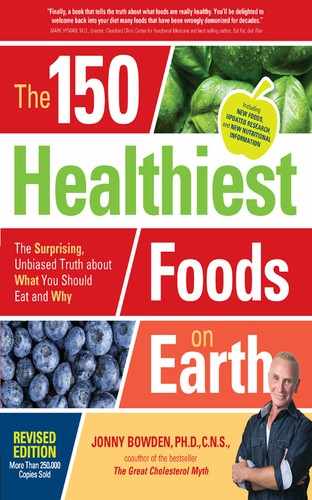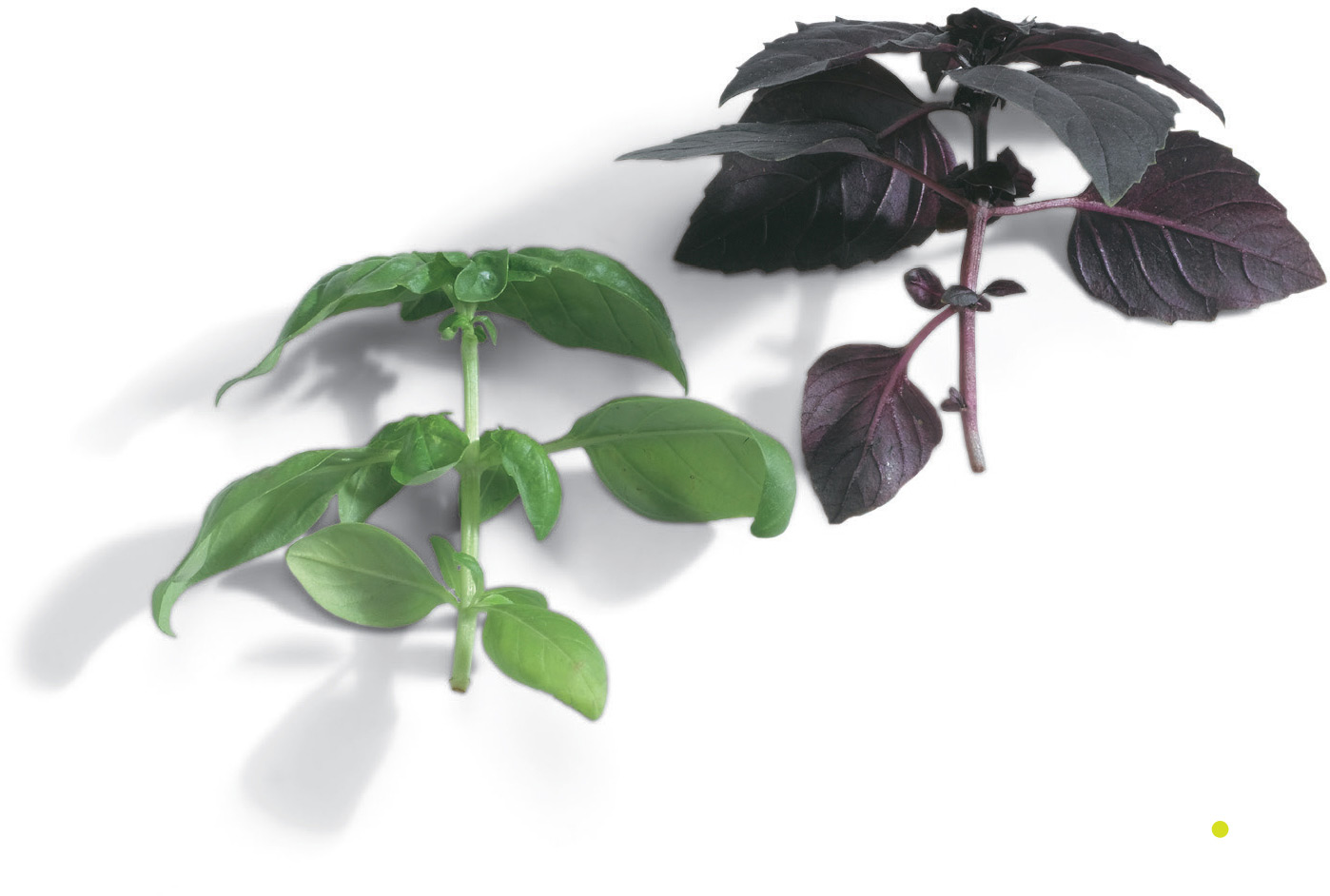
You know the old saying “variety is the spice of life”? Well, it should be the other way around. Spice is the variety of life.
Consider this: There are 25,000 phytochemicals, living plant compounds that continue to amaze with their résumé of significant health benefits. Spices are teeming with these compounds. They’re awash with healing properties that are constantly being uncovered. Cinnamon lowers blood sugar; nutmeg relieves nausea; cloves are anti-inflammatory; ginger relieves morning sickness; peppermint inhibits the growth of bacteria; cumin is great for digestion; cayenne pepper increases metabolism; chili powder eases pain; curry powder safeguards your brain; cinnamon stimulates circulation; cardamom soothes indigestion; turmeric is good for practically everything—the list is endless. Spices are truly the variety of life, nature in all its pungent and aromatic glory.
Spices and Herbs Are a Natural Source of Preventive Health Care
Historically, herbs and spices have been used for adding flavors and tastes to foods. They provide unique flavors and enhancing tastes to human diets. But most herbs and spices used in culinary purposes have a long list of potential biological effects on human health. The very spices that make food so delicious and appealing come from plants whose traditional use have included acting as medicinal remedies for preventing or treating human disease for many years. The phytochemicals isolated from plants have been a great resource for discovering a large proportion of commercially available medications for the treatment of a wide range of human diseases, such as pulmonary diseases, cardiovascular diseases, diabetes, obesity, and cancers. Spices and herbs are a natural means of preventive health care; just consider the health effects on human diseases that could be accomplished through daily diets rich in their medicinal phytochemicals. Spices are a great way to get a virtual phytopharmacy into our kitchens.
And these guys seem to work synergistically in ways that are only now beginning to be understood. In an animal study, when curcumin (found in turmeric) was mixed with phenethyl isothiocyanate (a compound found in cruciferous vegetables) the combo had significant protective effects on implanted prostate tumors—though neither compound used alone showed any effect. (Curried cabbage, anyone?) In the Journal of the American Nutraceutical Association, researchers tested a spice blend of turmeric, ensian root, hot paprika, and vanillin for its effect on cholesterol, and it was found to have “a beneficial and clinically relevant long-term effect,” decreasing non-HDL cholesterol by 16 percent. Which spice was “responsible”? Who knows? Who even cares? Use ’em all!
Plants and spices are literally teeming with health-giving phytochemicals that act and interact in a myriad of mysterious ways, and scientists will probably still be decoding their health secrets decades after everyone reading this book is gone. I think the best take-home point is to use as many of them as possible, use them often, and use them in every combination you can think of.
Cardamom

If you’ve ever eaten at an Indian restaurant, you’ve probably encountered cardamom. Cardamom is actually the dried, unripened fruit of a perennial member of the ginger family. The pods contain highly aromatic citruslike, floral-flavored seeds with menthol undertones. Most Indian restaurants have a little dish of these seeds at the entranceway, or at the cash register, much like other restaurants have after-dinner mints. That’s because when the seeds are chewed, they’re a terrific breath freshener.
As a spice or seasoning, cardamom seeds can be used whole or ground. Cardamom is actually one of the world’s most ancient spices. It’s mentioned all over the place in The Arabian Nights. It became very popular early in the twentieth century, when about 250,000 pounds were shipped each year to Britain alone. Today, cardamom is used in cooking, as a health remedy, as a coffee flavoring in Egypt, and as an aromatic agent in perfume—especially in France and the United States. And of course, as a parting gift in the above-mentioned Indian restaurants!
But cardamom does a lot more than make your mouth taste good after eating. It stimulates bile flow for liver health and fat metabolism. Health benefits of this delicious spice are legion: It’s been used as a digestive aid since ancient times, and is known for easing stomach cramps, stimulating digestion, and cutting mucus. Because it’s a carminative—an agent that induces the expulsion of gas from the stomach and intestines—it’s a terrific remedy for flatulence.
A wonderful way to consume it is as a tea, which you can easily make by simply pouring boiling water over about 2 teaspoons of the seeds. Let it sit for about 5 minutes, then drain, discard the seeds, and enjoy! (Many ancients believed a cardamom tea to be an aphrodisiac. Feel free to experiment and let me know the results.)
Real cardamom is expensive, second only to saffron in price, and there are lots of inferior substitutes from cardamom-related plants masquerading as the real thing. Only Elettaria cardamomum—its botanical name—is the real deal. Indian cardamom comes in two types—Malabar and Mysore. The Mysore variety contains higher levels of limonene, a valuable phytochemical that boosts the body’s synthesis of an enzyme that has antioxidant properties and helps detoxify chemicals. Limonene is also found in citrus fruit peels, cherries, celery, and fennel.
 Cinnamon
Cinnamon
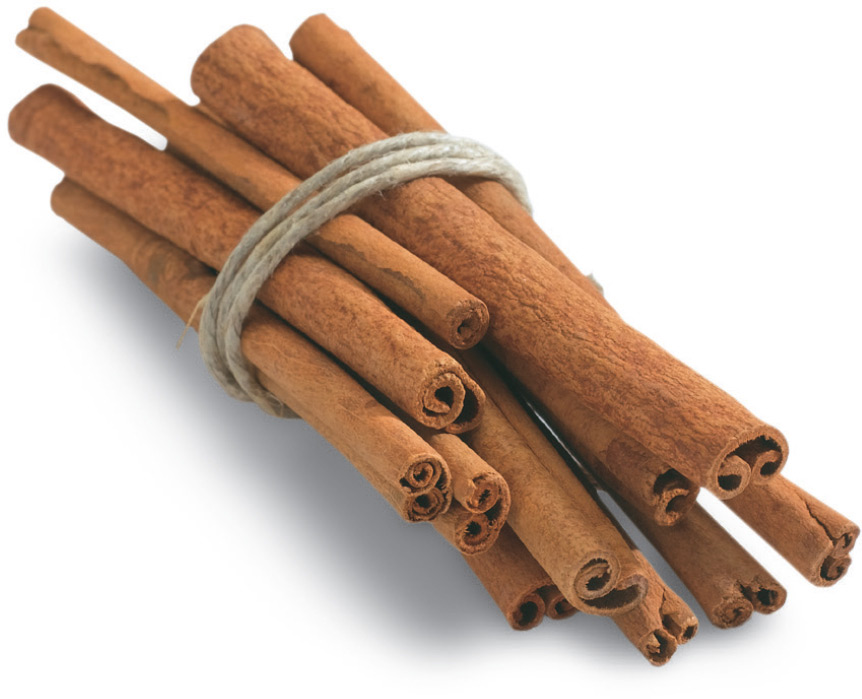
C. Leigh Broadhurst, Ph.D., is, quite simply, on the short list of the smartest people I know. She’s a research scientist at the USDA, and one of my “go-to” sources for the final word on any nutritional controversy. So back when Broadhurst told me about some exciting stuff her team was working on over at the USDA that involved ordinary cinnamon, believe me, my ears pricked up and I started taking notes.
Though cinnamon has a formidable reputation as a health-giving compound (more on that in a moment), the latest buzz about it has to do with its uncanny ability to moderate blood sugar. And in these days, with a growing epidemic of obesity and diabetes, that sort of stuff gets people’s attention. According to Broadhurst, plenty of plants and individual phytochemicals can lower blood sugar, but many of them accomplish this by imposing toxic costs on the body. Not this one. Broadhurst and her team identified new phytochemicals in cinnamon called chalcone polymers that increase glucose metabolism in the cells twentyfold or more.
Cinnamon also contains anthocyanins, which improve capillary function. A compound that has a similar molecular composition to the ones found by Broadhurst’s team has been shown to inhibit the formation of ulcers and increase blood flow to the stomachs in rats. The chalcone polymers that Broadhurst was so excited about are also powerful antioxidants.
Cinnamon Can Help with Pain and Stiffness in Muscles and Joints
Before I get to the practical use of cinnamon for modifying blood sugar, let me tell you about some other things this wonder spice can do for you. Cinnamon contains the phytochemicals eugenol and geraniol, which, according to registered dietitian and author Laurie Deutsch Mozian, can help combat candida, the overgrowth of yeast in the system that can cause so many problems. This is probably because these compounds have antimicrobial activity that can help stop the growth of bacteria and fungi (including Candida). Cinnamon also contains anti-inflammatory compounds that may ease the pain and stiffness of muscles and joints as well as menstrual discomfort.
Cinnamon is good for digestive function. Both in test-tube and in animal studies, cinnamon functions as what’s called a carminative, which means “gas reliever.” So if you have abdominal discomfort caused by excess gas, cinnamon would be a great thing to try. In addition, compounds in cinnamon called catechins help relieve nausea. And for whatever reason—we’re not really sure why—cinnamon is known for boosting flagging appetite. Maybe it’s the delicious smell or the evoked memory of Mom’s apple pie. Who knows? What we do know is that it’s very “digestive-friendly.”
Cinnamon Extract Can Reduce Blood Sugar and “Bad” Cholesterol
Now let’s get back to C. Leigh Broadhurst, Ph.D., and the team over at the USDA. They tested the effects on glucose metabolism of forty-nine different herbs, spices, and medicinal plants. As Broadhurst told me, cinnamon was the star of the show. The active ingredient—methylhydroxychalcone polymer, or MHCP—seems to mimic insulin function, increasing glucose uptake by cells and signaling certain kinds of cells to turn glucose into glycogen (the storage form of sugar). The study demonstrating that this active ingredient functioned as an “insulin mimic” was published in the Journal of the American College of Nutrition in 2001. Not long after, another study was published in Diabetic Care showing that cinnamon reduced not only blood sugar, but also triglycerides, total cholesterol, and LDL (“bad”) cholesterol in people with type 2 diabetes. The research hardly escaped the notice of the natural medicine community: The legendary integrative medicine guru Jonathan Wright, M.D., uses cinnamon extract as a component in vitamin supplements he designed for modulating blood sugar.
According to Broadhurst, one of the best parts of the whole cinnamon story is that you can get the best results with the cheapest stuff. In fact, she told me that you’re better off getting the really cheap stuff from the supermarket instead of any of the esoteric and expensive oil extracts, which may have some components that could be toxic if taken internally. Cinnamon powder has already had much of the essential oils removed during processing, so it’s a nonissue. “Buying cinnamon in bulk is cost-effective and highly recommended,” she told me.
Homemade Treatment for Blood Sugar
According to Broadhurst’s excellent book on diabetes, the best way to use cinnamon to help lower blood sugar and improve type 2 diabetes is to put 3 rounded tablespoons (about 24 g) of ground cinnamon and 1/2 to 1 teaspoon of baking soda (less if sodium is a problem for you) in a 32-ounce (946 ml) quart-size canning jar. Fill the jar with boiling water and let it steep at room temperature till it’s cool. Strain or decant the liquid, discard the grounds, put a lid on the jar, and stick it in the fridge. Drink one 8 ounce (235 ml) cup of the tea four times per day. After one to three weeks you can drop down to one or two cups a day. Type 1 diabetics can use it too, but should start with only one or two cups per day and increase by one cup per week, monitoring blood sugar closely.
And even if you’re not diabetic, this little spice does so many great things that it really deserves the label “superfood.”
Cloves
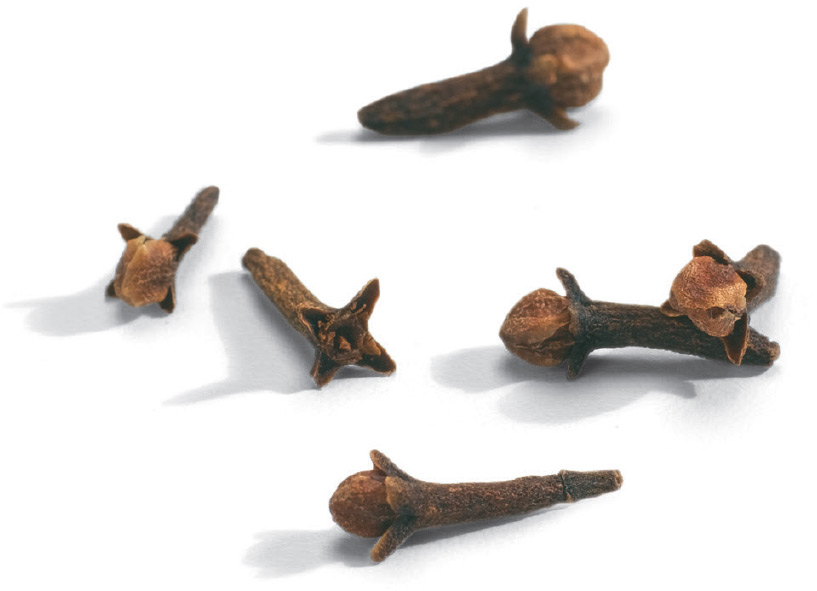
If anyone remembers seeing the terrific movie Marathon Man back in the 1970s, you’ve undoubtedly shuddered at the frightening scene where Dustin Hoffman was subjected to various unpleasantries in a dentist chair at the hands of Laurence Olivier. But you might also recall that the “antidote” that brought immediate pain relief was an oil made from cloves. The medicinal properties of cloves reside in the volatile oil, the same one that brought pain relief to Hoffman’s character in the movie. Cloves have long been used as an effective toothache remedy.
A clove is actually the dried, unopened flower bud of a type of tree that originated in the Spice Islands (Indonesia). Cloves look like tiny little nails, which is actually what their name comes from (clavus, which in Latin means “nail”). In Asian medicine, cloves are thought to be among the spices that promote energy circulation and increase the metabolic rate. The Council of Maharishi Ayurveda Physicians recommends one Red Delicious apple pierced with four cloves and boiled as the ultimate energy-enhancing winter dessert (throw away the cloves before eating). They also recommend clove, boiled with milk, to warm you up in winter. Sounds pretty good, actually.
Clove Component Kills Bacteria and Viruses
The highly respected panel German Commission E has approved the use of clove as an antiseptic and as an anesthetic. “The clove herb keeps food fresh because the main active component of cloves is eugenol, which has long been known to help kill bacteria and viruses,” says Gary Elmer, Ph.D., associate professor of medicinal chemistry at the University of Washington School of Pharmacy in Seattle. Interestingly, one study investigated the chemoprotective effect of a water solution of cloves on skin cancer and found that the clove solution had an anticarcinogenic effect.
One tablespoon (4 g) of cloves contains the full amount of the recommended dietary intake of manganese for women (and just a smidgen less than the recommended amount for men). Manganese is an important nutrient for bone formation, as well as for protein, fat, and carbohydrate metabolism. A tablespoon (4 g) of cloves also contains 43 mg of calcium, 73 mg of potassium, and 17 mg of phytosterols. And 1 tablespoon (4 g) of cloves contains a little more than 2 g of fiber.
Cumin

There’s a lot of confusion about the difference between cumin seeds and caraway seeds; they’re actually not the same thing, though they do belong to the same plant family. The seeds look almost identical; in curry recipes, you can pretty much assume that “caraway” means “cumin.” You can use cumin interchangeably in the seed or the powdered form.
There are some interesting Trivial Pursuit–type factoids about cumin, some of them having to do with romance: A paste of cumin, black pepper, and honey is considered to be an aphrodisiac in some parts of the Middle East. In Europe during the Middle Ages, cumin was believed to keep lovers from being unfaithful. Soldiers were sent off to war with cumin bread baked by their wives. Cumin was also believed to keep chickens from leaving their yard. And cumin is said to symbolize greed, maybe because its strong flavor can overwhelm a dish.
Almost all the cumin we use in the United States comes from India, but cumin is found in the cuisines of Indonesia, Thailand, and Mexico as well. For the best quality, you should look for it in a specialty market, such as one that specializes in the cuisine of these cultures. Whole cumin blends nicely into dishes like sautéed vegetables, or legumes and beans. Toasting the whole seeds in a skillet really enhances the flavor.
Cumin Decreases Allergy Symptoms
Cumin—also known as black seed or Nigella sativa—is an important medicinal herb. In many Arabian, Asian, and African countries, black seed oil is used as a natural remedy for a whole range of diseases, especially allergies. In four different studies using the oil from black cumin seeds, patients reported significantly fewer allergic symptoms. And one study found that it was effective in inactivating certain kinds of breast cancer cells, at least in a test tube. According to Laura Pensiero, R.D., cumin contains limonene, a phytochemical being studied for its role in blocking certain cancers.
In Indian medicine, cumin is considered to be a cooling herb. And according to Deepak Chopra, M.D., it helps reduce heartburn and improve digestion. You can make a great cup of tea by boiling the seeds and letting them steep—it’s frequently used that way to aid digestion. The essential oil of the seeds is antimicrobial. Plus cumin is a good source of iron—1 tablespoon (6 g) has almost 4 mg. It also contains 22 mg of magnesium, 107 mg of potassium, and 56 mg of calcium.
 Garlic
Garlic
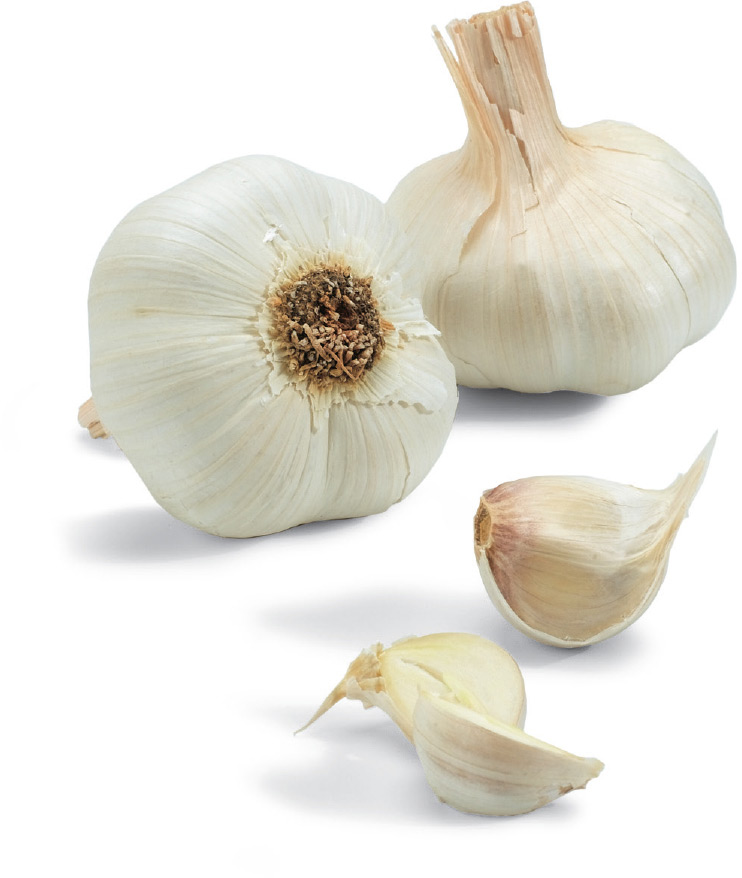
Garlic is a global remedy. It’s one of the oldest medicinal foods on the planet. The world’s oldest medical text, the Egyptian Ebers Papyrus, mentions garlic repeatedly. Garlic was fed to slaves and soldiers in the ancient world to keep them healthy. It’s been used to fuel the fighting spirit (ancient Greeks); fight leprosy, toothache, and chest pain (Hippocrates); and ward off vampires (almost any Dracula movie you can think of).
Okay, so maybe it doesn’t ward off vampires. Or fight leprosy. But garlic is hardly just a folk remedy. Consider this: Garlic is lipid-lowering, antithrombotic, anti–blood coagulation, antihypertensive, antioxidant, antimicrobial, antiviral, and antiparasitic. Impressive enough for you? All of these benefits have been documented in hundreds of peer-reviewed studies.
Garlic Lowers Cholesterol and Prevents Blood Clots
Garlic is accepted even by conventional, traditional medicine as an agent for lowering cholesterol. For the record, I no longer believe that lowering cholesterol matters all that much, as Stephen Sinatra, M.D., and I argued in our 2012 book, The Great Cholesterol Myth.
For those who might be interested, a meta-analysis published in the Journal of the Royal College of Physicians showed that garlic supplements lowered total serum cholesterol levels by 12 percent after only four weeks of treatment. Not only that, they lowered LDL (the so-called “bad” cholesterol) by 4 to 15 percent without lowering HDL (“good,” protective) cholesterol. In fact, garlic has actually raised HDL in some studies by up to 22 percent, and that’s pretty hard to do. Even more important, garlic lowers triglyceride levels by up to 17 percent.
Garlic can also reduce plaque, making it a powerful agent for cardiovascular health. In one study, subjects receiving 900 mg of garlic powder for four years in a randomized, double-blinded, placebo-controlled study had a regression in their plaque volume of 2.6 percent; a matched group of subjects given a placebo (an inert substance) saw their plaque increase over the same period of time by 15.6 percent.
One of the active ingredients from garlic—allicin—also has significant antiplatelet activity. That means that it helps prevent platelets in the blood from sticking together. To understand how important that is, consider that many heart attacks and strokes are believed to be caused by spontaneous clots in the blood vessels. The anticoagulant effect of garlic is an important health benefit.
The Anticancer Properties of Fresh Garlic Extracts, Aged Garlic, and Garlic Oil
Then there’s cancer. Compounds in garlic have been shown in many laboratory studies to be chemoprotective. Epidemiological evidence shows a decreased risk of stomach and colon cancer in areas where the consumption of garlic and other vegetables in the allium family is high. An article in the Journal of Nutrition stated that “evidence continues to point to the anticancer properties of fresh garlic extracts, aged garlic, garlic oil and a number of … compounds generated by processing garlic.”
One research article demonstrated the ability of aged garlic extract to inhibit the proliferation of colorectal cancer cells. And yet another study demonstrated the ability of another compound from garlic—diallyl disulfide—to inhibit leukemia cells in a test tube.
Garlic can even help fight the common cold. In one study published in Advances in Natural Therapy, a group of seventy patients was given a high-quality standardized garlic supplement for twelve weeks while another group of seventy-two patients was given a placebo. The garlic group had only twenty-four colds over the course of the study, compared to sixty-five for the placebo group. What’s more, the average duration of symptoms was less than half for those taking the garlic.
Studies have shown that garlic exerts antimicrobial activity against bacteria, viruses, fungi, and parasites. The antibacterial properties of allicin were written about as far back as 1944 in a paper published in the Journal of the American Chemical Society.
Garlic also has a positive effect on blood pressure. The effect is not enormous, but it is significant. A number of analyses have concluded that garlic can modestly reduce blood pressure by 2 to 7 percent after four weeks of treatment. An article in the Journal of Clinical Hypertension in May 2004 called garlic “an agent with some evidence of benefit” in reducing hypertension (others were coenzyme Q10, vitamin C, fish oil, and arginine). And the protocols of the Hypertension Institute of Nashville at St. Thomas West Hospital include a particularly high-quality, stable form of garlic called Allicidin by Designs for Health as part of their dietary and supplement regimen for both hypertension and high triglycerides.
Add Garlic to Your Weight Control Toolbox
And get this: New research shows that garlic might hold some promise for weight control. In this research, rats were fed a high-fructose diet designed to make them fat and hypertensive. It worked. Fat and hypertensive they were, with high triglycerides to boot. Then, one of the groups was given allicin (the active ingredient in garlic), while the bad diet continued. The allicin group lowered its blood pressure, insulin, and triglycerides. What’s more, even though they were consuming the same amount of food, the rats given allicin stopped gaining weight. Even more impressive, a third group, given allicin from the beginning of the study, gained very little weight despite eating the exact same bad diet.
Even though it’s a rat study, that’s pretty impressive, don’t you think? And no, the take-home message from that isn’t to add garlic to your fast-food diet! Meanwhile, another study found that diabetic rats fed garlic oil had increased insulin sensitivity. Garlic may well turn out to be a useful addition to the weight control toolbox.
Crushing or Chopping Garlic Releases Its Full Potential
The key to the astonishingly wide range of health benefits in garlic seems to lie in a compound called allicin. The thing of it is, allicin isn’t actually in garlic. Garlic cloves contain an amino acid called alliin. When the garlic is crushed or damaged, the alliin reacts with an enzyme found naturally in garlic called allinase. Nature designed it so that the alliin and the enzyme allinase live in different compartments of the garlic plant, and they’re meant to react only when necessary to protect the plant from attack or when it’s crushed. The action of the enzyme allinase on the amino acid alliin produces, presto: allicin, probably the most important of the medicinal compounds unique to garlic and responsible for many of its marvelous health benefits.
Why is this important to understand? Because the preparation of garlic is critical for it to release its health-providing benefits. If you were, for example, to swallow a garlic clove whole—not that you’d want to—not much would happen. The garlic clove has to be crushed, or chopped, the more finely the better, for the compounds to interact.
Allicin starts to degrade after it’s produced, so the fresher it is when you use it, the better. Microwaving appears to destroy it completely—sorry. Garlic experts advise crushing a little raw garlic and combining it with the cooked food shortly before serving. Eating it raw isn’t recommended because it can be irritating to the stomach.
Now here’s the deal with garlic supplements: In a laboratory, dried garlic powder gets added to water so that the alliin and allinase can quickly react to make allicin. The amount of allicin produced is the measure of “allicin potential.” But when such garlic supplements are swallowed, the enzyme is destroyed by stomach acid. That’s why some garlic products are enteric coated—to protect them against stomach acid.
Unfortunately, many supplements still don’t work as advertised and don’t release their “allicin potential” as promised. It is entirely possible that the variable results sometimes obtained in studies on garlic supplementation happen because of variation in the quality of the garlic supplements and lack of standardization of the allicin content. This is not to say don’t use garlic supplements—absolutely do!—just use very high-quality ones that are standardized for allicin content, not allicin potential.
 Ginger
Ginger

In Ayurvedic medicine, ginger is known as the “universal remedy.” No wonder. This little plant contains a whole pharmacy of ingredients with multiple health benefits.
Ten years ago, when this book first came out, ginger was mainly known for its wonderful ability to soothe an upset stomach and end nausea. But we’ve since discovered so many more things about ginger that I’ve elevated its status and given it a star. My colleague, Kris Gunnars of Authority Nutrition, says “Ginger is one of the very few ‘‘superfoods’” that is actually worthy of that term.”
The active ingredients in ginger are gingerols, shogaols, gingerdiones, and zingerone, all of which are antioxidants. The zingerone and the shogaol in ginger also have anti-inflammatory properties and might be useful in a nutritional program for arthritis and/or fibromyalgia. And at the Frontiers in Cancer Prevention Research conference, research was presented that suggested that gingerols may inhibit the growth of human colorectal cancer cells. In mice, ginger extract lowered cholesterol, inhibited the oxidation of LDL cholesterol (which is even more important), and slowed the development of atherosclerosis. Not exactly a bad résumé.
Many people are already aware of ginger’s awesome ability to soothe an upset stomach and end nausea. By stimulating saliva, it may also help digestion. And ginger ale has long been a favorite for upset stomach for a very good reason: It works. In one study, ginger performed better than Dramamine in warding off seasickness. And the previous mentioned active ingredient gingerol—which is the ingredient responsible for the pungent and delicious taste—is listed in the USDA database of phytochemicals as an antiemetic, meaning it has the property of preventing nausea and vomiting.
Ginger Battles Morning Sickness
Studies from Denmark found that almost 75 percent of pregnant women who used ginger experienced relief from their morning nausea without limiting side effects. Because many drugs are avoided during pregnancy because of risks to the fetus, this makes ginger an excellent herb to have around while you’re pregnant.
The benefits of ginger aren’t limited to morning sickness—or even sea sickness. It may also help with simple indigestion. It’s generally believed that indigestion is more likely to happen to people whose stomachs take a long time to empty. In two separate studies, ginger sped up stomach emptying—which might make it helpful for people with chronic indigestion.
But wait! There’s more!
Gingerol does a lot more than just settling your stomach. Research shows it’s a powerful antioxidant, and has strong anti-inflammatory properties as well. In one study of 247 people with osteoarthritis of the knee, people taking ginger extract required less pain medication and experienced less pain.
Two grams of ginger powder daily will also lower blood sugar. A 2015 study tested the results of 2 g of ginger powder daily with diabetic patients and found that the people taking the powder lowered their fasting blood sugar by 12 percent, as well as improving their hemoglobin A1C levels by 10 percent over the course of three months. (Hemoglobin A1C is a blood test usually used to diagnose diabetes.)
Animal studies show that ginger can protect against age-related decline in brain function, and in one human study—on sixty middle-aged women—ginger extract improved both working memory and reaction time.
It’s effective in helping fight infections. Ginger extract can put a damper on the growth of several different types of bacteria, and it works against the same oral bacteria that is associated with inflammatory gum disease (periodontitis, gingivitis.)
Animal studies on ginger also show that it has antitumorigenic effects and helps boost the immune system; it’s an effective antimicrobial and antiviral agent. Studies also demonstrate positive effects on the gastrointestinal tract, the cardiovascular system, pain, and fever. No wonder that a nice hot ginger tea with lemon is a home remedy for all sorts of variations of feeling under the weather.
One benefit that has been noted for thousands of years is ginger’s ability to improve circulation. At the Deepak Chopra Center, they routinely give ginger as a remedy for people with cold hands and feet, something that Chinese and Indian physicians have done for eons.
Personally, I put ginger in a lot of things I eat and drink. I almost always include it in juices. And lately, I’ve taken to infusing my regular drinking water with some fresh lemon peel and ginger root; I keep the lemon and ginger in the water overnight, and drink it during the next day. It’s an easy way to get some powerful antioxidants and anti-inflammatories along with your daily H20.
Mustard Seeds
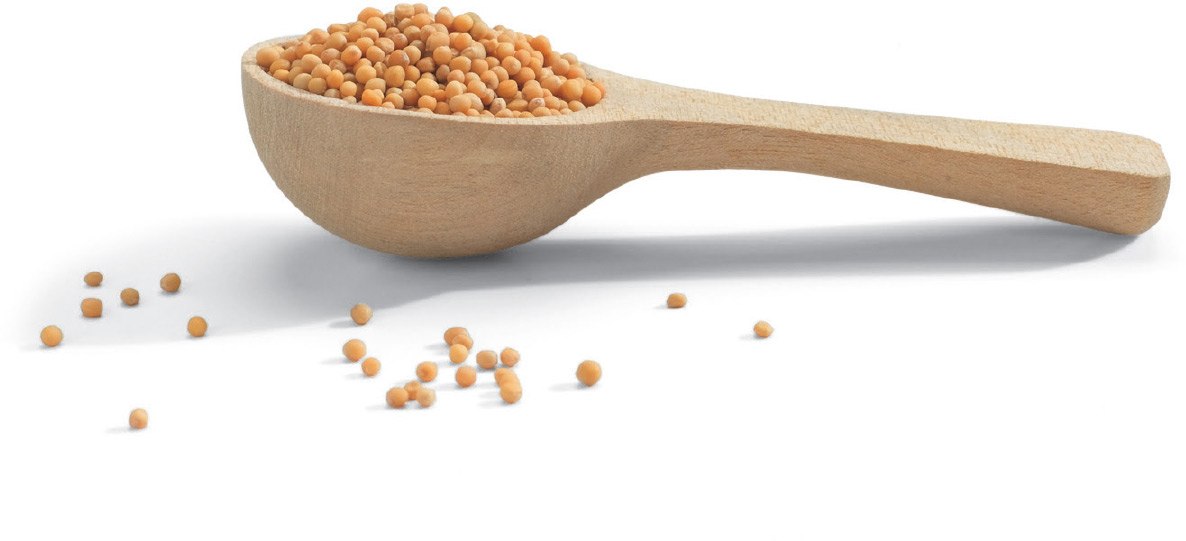
Mustard seeds are, believe it or not, members of the Brassica family, giving them a distinguished pedigree and putting them in the company of several nutritional superstars. Other members of the Brassica family include cabbage, broccoli, Brussels sprouts, and kale, and they are all loaded with cancer-fighting substances such as indoles, isothiocyanates, and sulforaphane. One of the key dietary recommendations of the American Cancer Society is to include these cruciferous vegetables in your diet on a regular basis.
So mustard seeds come from veggie royalty. Other members of the same plant family include horseradish (see here) and cress. Mustard seeds, like their relatives, are able to produce isothiocyanates, which are aggressive substances that have the function of a chemical weapon against the plant’s predators.
Because these isothiocyanates are dangerous to the plants as well, they are stored in the plant organism as glucosinolates, which are harmless. By an enzymatic reaction that happens whenever the plant tissue gets damaged—like, for example, if it’s chewed—the isothiocyanates are quickly formed. Many of these isothiocyanates have been found to have significant roles in human health, as protectors against carcinogens. Mustard seeds are a source of one particular compound, allyl isothiocyanate, which is believed to play a role in the prevention of tumors and the suppression of tumor growth.
Mustard Seed Is Rooted in History
In fact, the use of mustard (and mustard seeds) as a medicinal plant predates all the science on phytochemicals. From its beginnings, mustard was considered a medicinal plant rather than a food; Hippocrates, the father of modern medicine, used mustard in all sorts of medicines and poultices. The ancient Chinese considered mustard an aphrodisiac. And the mustard seed figures prominently as a symbol in the Christian faith, used to signify something small and insignificant that, when nourished, can grow into something of great strength and power.
Mustard itself is only as good as the seeds it was made from. There are many delicious gourmet mustards loaded with phytochemicals. Seek them out! Good mustard can stimulate the appetite and circulation and help neutralize toxins. If you’re adventurous, use the seed in cooking. Mustard seeds as a culinary ingredient is popular in Western and Asian cuisines.
 Oregano
Oregano
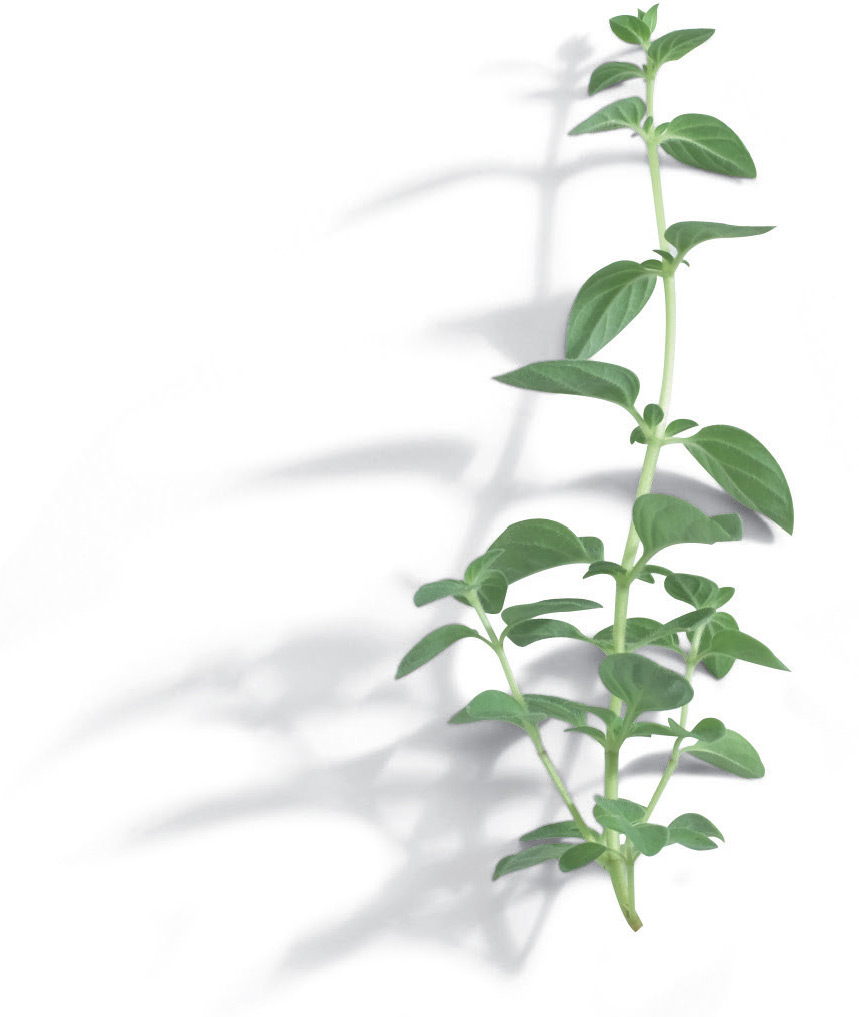
Every so often, a doctor or healer gets so excited about one herb, food, nutrient, or ingredient that he or she writes a whole book singing its praises. That’s exactly what happened to Cass Ingram, D.O., and the result was a little book called The Cure Is in the Cupboard. The herb that got Ingram so excited that he decided to write a book about it? Oregano.
Read the research on this herb and it all becomes clear. Oregano is rich in a host of nutrients, including calcium, magnesium, zinc, iron, potassium, copper, boron, manganese, vitamin C, vitamin A, and niacin. Oregano also seems to be the herb with the highest antioxidant activity. According to a study published in the Journal of Agricultural and Food Chemistry, oregano has forty-two times more antioxidant activity than apples, thirty times more than potatoes, twelve times more than oranges, and—maybe most surprising of all—four times more than the amazing blueberries! But that’s only the beginning.
Oregano Oil Has Medicinal Benefits
The medicinal parts of this plant are contained in the oil extracted from the leaves or from the herb itself picked during the flowering season and eaten fresh or dried. The essential oil contains thymol (see Thyme) and carvacrol, compounds that have antifungal, antibacterial, and antiparasitic properties. In one study, 77 percent of patients treated for enteric parasites were parasite free after taking oil of oregano in tablet form for six weeks. As of 2017, it has inhibited the growth of at least ten different microbes, including Candida albicans (yeast).
To top it off, oregano—like its relative rosemary—contains the powerful compound rosmarinic acid (see Rosemary), which has been found to have antimutagenic and anticarcinogenic properties.
Traditionally this herb’s oil has been used as a digestive aid and, because of its anti-inflammatory properties, to support joint function. Plenty of health benefits come from using the herb regularly, but for special conditions—such as Candida or inflammation—a health professional may suggest oil of oregano supplements.
Parsley
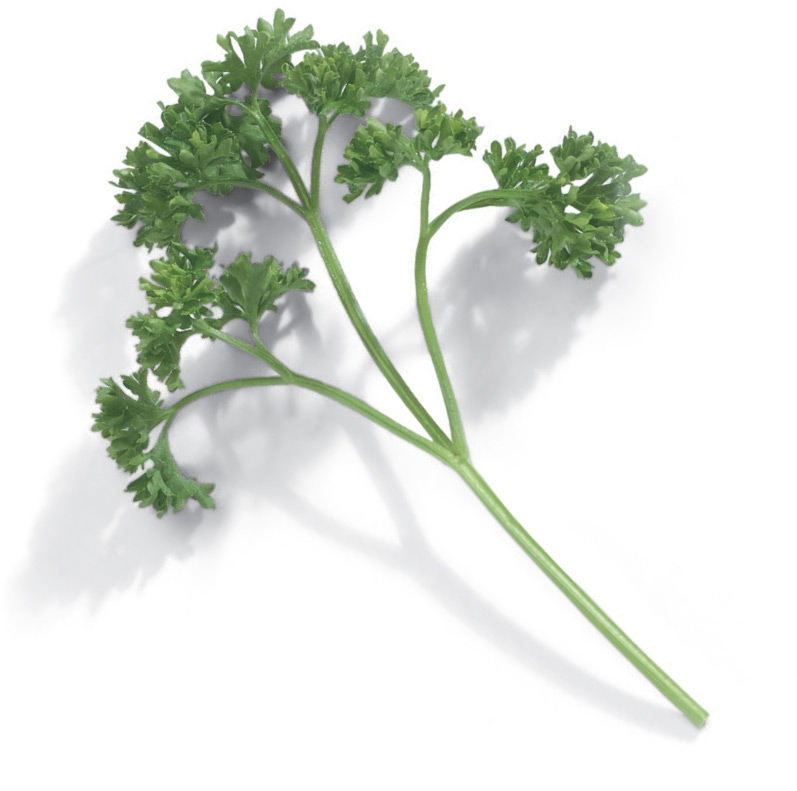
If you’ve ever chewed on a sprig of parsley after a meal (and before kissing your date), you’ve experienced its ability to freshen the breath firsthand. What you might not know is that it has the same ability to freshen the whole system.
Parsley is known for its detoxification (and deodorizing) properties. It’s the world’s most popular herb. The Greeks wore parsley crowns at their banquets to stimulate their appetite. Peter Rabbit went looking for some parsley when he overate Mr. McGregor’s vegetables. And the Romans believed that nibbling on parsley sprigs would allow them to drink more wine without becoming drunk. From ancient times to the modern dinner table, people have known intuitively of parsley’s ability to detoxify. And modern science has begun to confirm what the ancients suspected.
Use Parsley to Purify
Its ability to freshen the breath—and to detoxify the system—comes from the same substance that makes it green: chlorophyll. Dozens of studies have confirmed the ability of chlorophyll to purify and rejuvenate—and it has been shown to stop bacterial growth in wounds, it deodorizes, and it counters toxins, it deactivates many carcinogens, and it builds blood, renews tissues, and counteracts inflammations. In Asian traditions, chlorophyll benefits anemic conditions; it also helps kidney function, probably because it has mild diuretic properties.
Parsley is used by diabetics in Turkey to reduce blood glucose; in one published study, an extract from parsley significantly reduced the blood glucose of rats and reduced their weight! A second study demonstrated parsley’s ability to protect the livers of diabetic rats as well. Wouldn’t it be interesting if parsley turned out to be another plant weapon in the armamentarium against blood sugar challenges, obesity, and diabetes?
Parsley Part of a Select Group of Cancer Fighters
There’s also some suggestion that the volatile oils in parsley—especially one called myristicin—may inhibit tumors. The National Cancer Institute, which has invested millions and millions of dollars researching the anticancer potential of plant foods, found that umbelliferous vegetables (which include parsley) are among a select group of about a dozen foods with the highest anticancer activity.
Ten sprigs of parsley contain 556 mcg of the eye-protective carotenoids lutein and zeaxanthin, as well as 505 mcg of beta-carotene, 164 mcg of bone-building vitamin K, and 842 IUs of vitamin A. Oh, and if you’re lucky, while you’re shopping you might occasionally come across parsley root, a special variety of parsley grown for its root. It looks like a baby parsnip and usually has the parsley greens attached. I’ve never tried it, but it’s supposed to be delicious in soup as well as having medicinal properties for the stomach.
Rosemary

Rosemary has a poetic and romantic past. It flourishes in the Mediterranean, the south of France, and Portugal. It bears beautiful little blue flowers that are the stuff of legend. Its fragrant properties have been used in aromatherapy since the fourteenth century. And its medicinal properties, known and appreciated by herbalists for hundreds of years, are now being confirmed by research.
Some of the health-promoting benefits of rosemary come from two of its constituents, caffeic acid and rosmarinic acid, plus plant compounds like diterpenes and monoterpenes, and antioxidants like vitamin E and assorted flavonoids. The acids are anti-inflammatory, and may be helpful in reducing the inflammation that contributes to asthma, liver disease, and heart disease. Exciting research has been done on rosemary’s potential for inhibiting cancers such as breast, colon, and skin cancers; animal studies have confirmed that the oil is liver protective, antimutagenic, and tumor inhibiting. The oil is also mildly antibiotic and antiviral, probably because of the diterpenes.
And Shakespeare was on to something when he associated rosemary with memory (“There’s rosemary, that for remembrance: pray you, love, remember.”) Herbalists have treated rosemary as helpful for the brain as far back as the seventeenth century, when the English physician Nicholas Culpeper wrote that rosemary helps “weak memory, and quickens the senses” as well as “diseases of the head and brain, as the giddiness and swimmings therein… .”
Rosemary Works Like an Alzheimer’s Drug
As it turns out in the light of modern science, rosemary contains several compounds that prevent the breakdown of acetylcholine, an important neurotransmitter in the brain and one that is needed for memory and healthy brain function. (In fact, one drug used for Alzheimer’s—Aricept—works similarly, by interfering with acetylcholine breakdown.)
Besides being used widely as a culinary herb, rosemary frequently lends its distinctive fragrance to soaps and cosmetics. Aromatherapists use rosemary oil in baths and massage lotions, and they consider it to have an enlivening quality that promotes healing and happiness.
Sage
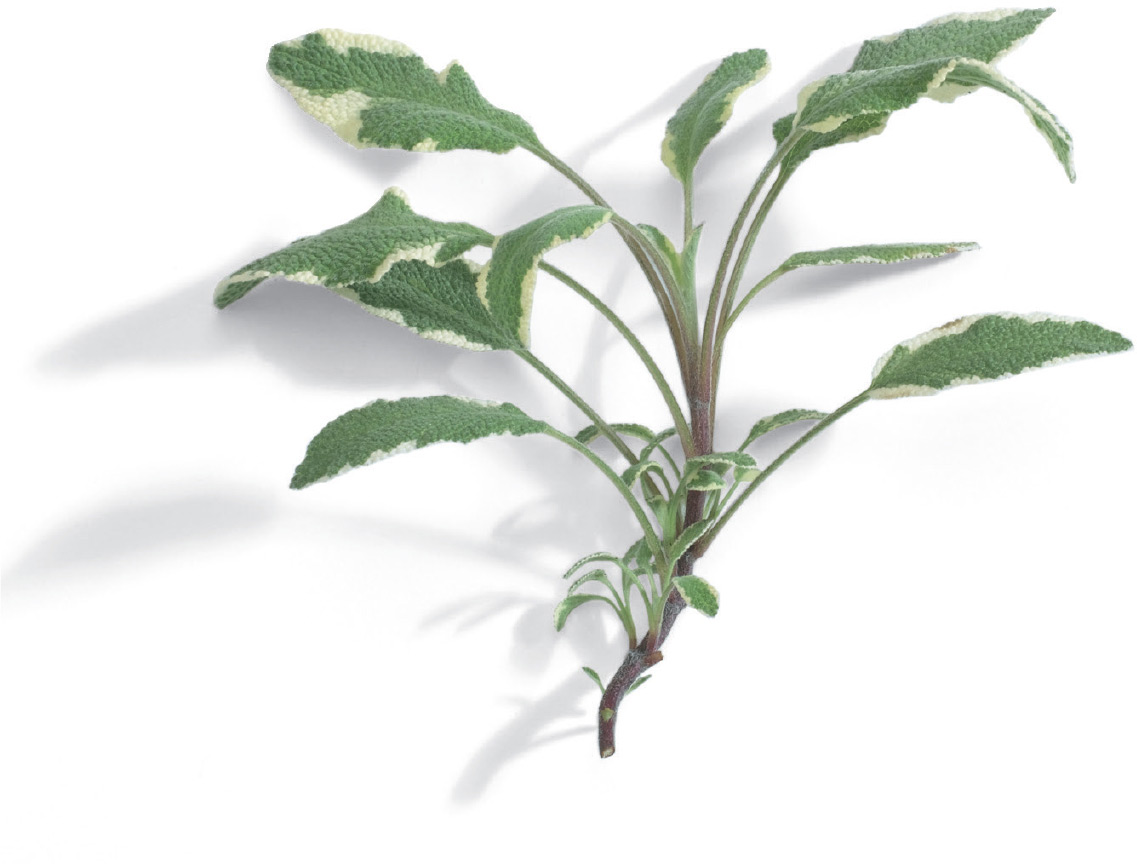
Sage is a great little herb, which has been valued for more than 2,000 years, both for its medicinal properties and for its ability to spice up foods. In Ayurvedic medicine, sage is considered a purifying herb. Deepak Chopra recommends it for “excessive accumulation of toxic, morbid emotions.” On top of that, it also smells great!
Sage probably got its reputation as a purifying herb because, along with its sisters in the mint family, it has antimicrobial and antiviral activities. Why? Because of its volatile oil. Oil of sage contains a compound called thujone, an effective agent against both Salmonella and Candida. Sage also contains the phenolic acid rosmarinic acid, which is both an antioxidant and an anti-inflammatory. For this reason, sage has been found to be beneficial for fighting such inflammatory conditions as gingivitis and rheumatoid arthritis.
In animal research, sage has been found to be hypertensive (it lowers blood pressure). In diabetic patients, it’s been found to improve glycemic control, lower triglycerides, lower hemoglobin A1C, and raise HDL cholesterol compared to placebo. Something herbalists have known for a long time is that sage works as a memory enhancer. In one study, Alzheimer’s patients given sage extract had a significantly better outcome on cognitive function tests than those given a placebo. Sage was also found to enhance memory in healthy young volunteers as well. Sage has been used for combating indigestion, excessive perspiration, and sore throats. And if that weren’t enough, it’s also been found to be helpful with menopausal night sweats.
Thyme

Although a generation of baby boomers probably first heard the name of this herb through the immortal Simon and Garfunkel song, it’s actually been around since the days of the ancient Greeks and Romans, who valued it as an aphrodisiac. In fact, Euell Gibbons, in Stalking the Healthful Herbs, said, “According to ancient tradition, if a girl wears a corsage of wild thyme flowers, it means that she is looking for a sweetheart; and according to another tradition, if a bashful boy drinks enough wild thyme tea, it will give him courage to take her up on it!” I don’t know about that, but I sure get warm and fuzzy when I hear the Simon and Garfunkel song.
Thyme is one of a naturally occurring class of compounds called biocides, meaning compounds that can destroy harmful microbes. The primary fragrant oil of thyme is thymol, a powerful antiseptic. You’ve probably felt its medicinal effects if you’ve ever gargled with Listerine. Research from Canada shows that thymol can reduce bacterial resistance to drugs such as penicillin. And Portuguese researchers have reported that thyme oil—even low amounts of it—act as a kind of natural preservative, fighting against a number of common foodborne bacteria that can cause sickness, while Polish researchers found that thyme oil was very effective against the bacterial strains of Staphylococcus, Enterococcus, Escherichia, and Psudomas genera.
Thymol is also a wonderful antioxidant and anti-inflammatory agent. Thyme essential oil fungal cream was found to work on eczema-like lesions in 66.5 percent of those treated with it compared to 28.5 percent of those using placebo. Thyme essential oil also helps kill yeast cells.
It’s a terrific aid to digestion: Thyme can help dislodge the mucus coating of the intestinal tract and has a long history in relieving chest and respiratory problems such as coughs and bronchitis—probably why it’s used in many over-the-counter vapor rubs or cough drops. Because it is antiseptic, thymol often shows up as an ingredient in natural toothpastes.
The herb itself is typically used for flavoring any kind of slow cooked-dish (soups and stews), and it is a nice addition to a bouquet garni. Rebecca Wood, a noted author and authority on whole food, suggests adding 3 tablespoons (13 g) of dried thyme to boiling water and honey for a homemade cough syrup she swears is more effective than any of the ready-made kinds.
 Turmeric
Turmeric
If there were ever a contest for a spice that deserved a whole book written about it, turmeric would be the clear winner. It’s pretty much my favorite spice, not only for the almost encyclopedic list of health benefits (more about that in a moment) but also for the incredible taste. Turmeric is a staple in India, where 94 percent of the turmeric in the world originates. It’s the spice that gives Indian food its distinctive flavor. It’s an important part of curry, so every time you’re eating anything with a curry sauce, you’re eating some turmeric. I use it on just about everything, but my latest discovery is how great it tastes on scrambled eggs and veggie omelets.
Turmeric is a member of the ginger family, and the plant’s healing properties reside in its fingerlike stalk. The part of the plant that is actually used is called the rhizome. Turmeric itself contains a bunch of compounds, but the family of compounds thought to be most responsible for turmeric’s medicinal effects are the curcuminoids, which are also responsible for giving turmeric its bright yellow color. The most important—and the most studied of the curcuminoids—is curcumin. Some of the studies mentioned below were done on curcumin, but the benefits apply equally to the turmeric plant that contains it.
Turmeric Known for Alleviating Arthritis and Joint Inflammation
Curcumin—the active ingredient in turmeric—is a powerful anti-inflammatory. So powerful that it actually matches the effectiveness of a number of anti-inflammatory drugs. Among its other actions, curcumin blocks a molecule called NF-kappaB, which turns on genes related to inflammation and plays a role in a host of chronic diseases. It also boosts an important hormone in the brain known as BDNF (Brain-Derived Neurotrophic Factor) which is basically Miracle-Gro for your brain cells. Low levels of BDNF have been linked to both depression and Alzheimer’s disease. Trust me—you want a lot of BDNF hanging around in your brain, and curcumin helps that to happen.
Turmeric is part of the healing systems of India, China, and the Polynesian Islands, and occupies a place of distinction in both Ayurvedic and Chinese medicine. One reason is its anti-inflammatory properties, which are believed to be due to the presence of the aforementioned curcuminoids. One of turmeric’s many traditional uses has been for the treatment of arthritis, because of its ability to lower inflammation. In one study, curcumin was found to be virtually as effective as the anti-inflammatory medication phenylbutazone. It’s used in India to relieve arthritis, and can be useful for muscle pains as well as joint inflammation and even carpal tunnel syndrome. If you’re interested in why it works so well, one school of thought is that it exerts its anti-inflammatory effect by lowering histamine levels; other experts are not sure of the exact mechanism. In the long run, who cares? It works as an anti-inflammatory, and does it without any toxic side effects. That’s what matters.
And then there’s cancer. There are at least thirty published studies indicating that curcumin has an antitumor effect (either reducing the number or size of tumors or the percentage of animals who developed them). Of course these are mostly animal studies, but still, that’s pretty promising. And not all the studies are on animals: One study, published in 2006 in the medical journal Oncogene, showed that curcumin inhibited the growth of human colon cancer cells. Though no one is claiming that turmeric cures cancer, there is plenty of reason to believe that it is a useful adjunct to the diet of everyone concerned with staying healthy.
Curcumin has powerful antioxidant properties as well as being highly anti-inflammatory. In one rat study, for example, curcumin provided significant protection from cataract development induced by a powerful oxidizing chemical. The group of rats treated with curcumin not only had protection against the damage done by this chemical, but the transparency of the lenses in their little eyes was improved as well. Many other studies have demonstrated curcumin’s antioxidant capabilities. In science jargon, curcumin “inhibits lipid peroxidation,” which means it fights damage from oxidating substances that age the body and contribute to disease. In other words, it’s good stuff.
Why Your Liver Loves Turmeric
This ability to fight inflammation and also to serve as an antioxidant makes curcumin a very liver-friendly food. I like to recommend it for people with various liver ailments, including hepatitis. Though it’s not the only thing I would use for serious liver problems, it’s definitely part of the arsenal. One study, in the journal Toxicology, demonstrated curcumin’s significant liver protection in male rats largely through its aforementioned antioxidant properties. Mark Stengler, N.M.D., author of The Natural Physician’s Healing Therapies, also recommends it for hepatitis and says that it is frequently used to lower elevated liver enzymes.
Turmeric is also one of the easiest spices to use. It has a really pleasing taste and a beautiful color, and it tastes good on almost any food you can think of. Deepak Chopra says that “its traditional purifying effect makes it a useful spice for people participating in a detoxification program.” In addition to cooking with it, you can also mix it into a paste with water and apply it directly to irritated skin (including pimples) before bedtime. Chopra also suggests mixing turmeric powder with a little honey and using the mixture to coat your throat at the first sign of a sore throat.
So we already know the strong science behind the pharmacy that lives in the turmeric plant. What does traditional Eastern medicine say about it? According to The Yoga of Herbs: An Ayurvedic Guide to Herbal Medicine, coauthored by David Frawley, O.M.D., and the highly respected Indian doctor and herbal authority Vasant Lad, M.A.Sc., “Turmeric gives the energy of the Divine Mother and grants prosperity. It is effective for cleansing the chakras and purifying the channels of the subtle body.”
When modern Western science and traditional forms of healing such as Ayurvedic and Chinese medicine both agree on the healthful properties of the same compound, it’s time to go to the store.
Vinegar
(apple cider vinegar)
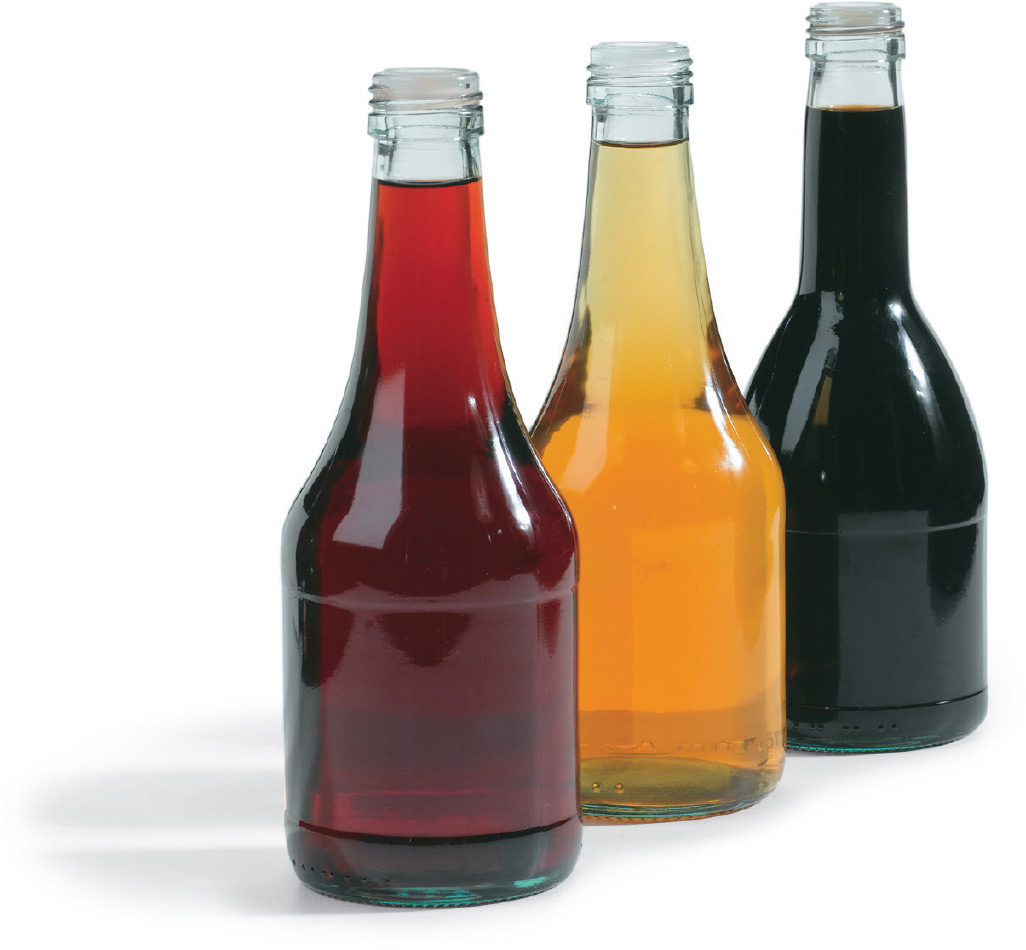
Vinegar was discovered by chance more than 10,000 years ago. It gets its name from the French, vin aigre—meaning “sour wine.” Vinegar is made when fresh, naturally sweet cider is fermented into an alcoholic beverage (hard cider). Then it’s fermented once again. The result is vinegar. You could say that wine is to grapes what vinegar is to wine.
Vinegar can be made from any fruit, or from any material containing sugar that can be fermented to less than 18 percent ethyl alcohol (including such things as honey, maple syrup, beets, potatoes, and coconut). When it’s made from apples, it’s called apple cider vinegar (more about that in a moment). The U.S. Food and Drug Administration (FDA) requires that any product called “vinegar” contain at least 4 percent acidity. This requirement ensures the minimum strength of the vinegar sold at the retail level. According to whole-food expert and author Rebecca Wood, you shouldn’t use aluminum, copper, or cast-iron when cooking with vinegar, because that 4 to 6 percent acidity is corrosive. And if you want to retain the acid flavor of vinegar, stir it in after removing the dish from the heat.
So why is vinegar listed in the world’s healthiest foods? Simple. It’s a virtual infusion of healthy minerals, vitamins, and amino acids. In fact, unpasteurized vinegar can contain as many as fifty different nutrients, including those that come from the original material the vinegar is made from (such as apples). But note well the term unpasteurized. Remember that pasteurization is basically a process that subjects foods to tremendous amounts of heat. That has the “benefit” of destroying microorganisms, but it’s a dubious benefit when it also destroys the heat-sensitive vitamins and enzymes that made it a good food to begin with. To get the health benefits of vinegar, you should look on the label for key terms like unpasteurized, unfiltered, traditionally brewed, traditionally fermented, or aged in wood.
Real Organic Vinegar Beats Common Supermarket Vinegar
Traditionally fermented foods are among the healthiest on the planet, and vinegar is no exception. The clean white vinegar you get at the supermarket is a food chemist’s invention made from coal tar and has none of the health properties of real, fermented, organic vinegar. Distilled vinegar is no better. Distilling turns the vinegar into steam and in the process destroys the natural malic and tartaric acids, which are important in fighting body toxins and inhibiting unfriendly bacteria. To get the health benefits of vinegar, get the real thing.
The best known of the vinegars in natural health circles is the kind made from apples. Apple cider vinegar is cheap and easy to use, and it benefits our health in numerous ways. Hippocrates, the father of medicine, thought of it as a powerful elixir and a naturally occurring antibiotic and antiseptic. Ancient Egyptians, Romans, and Greeks used it. And apple cider vinegar is mentioned in the Bible as an antiseptic and healing agent. Even Columbus had barrels of vinegar on his ships for the prevention of scurvy. Indeed, apple cider vinegar has been used for thousands of years, as both a health and a cleansing agent.
Is Apple Cider Vinegar Really a Cure-All?
Books have been written touting apple cider vinegar’s benefits for everything from weight loss to osteoporosis to arthritis. Whether it does all the things its proponents claim it does is another matter. I found a humorous “poem” by Patricia Carrol, R.N., M.S., extolling vinegar’s many benefits but also offering the following caution: Beware of claims too good to be true—For research backs up but a few.
There’s no doubt in my mind that apple cider vinegar is good for you. I’m just suspicious of whether it’s a cure-all. That said, there are a lot of terrific things to be said about real, unpasteurized vinegar made from apples. It’s nutrient rich, containing minerals such as potassium, phosphorus, natural organic fluorine, silicon, trace minerals, and pectin as well as many other powerful nutrients and enzymes. Over the centuries, oxymel—a combination of apple cider vinegar and honey—has been widely used to dissolve painful calcium deposits in the body, and for other health problems such as hay fever. And while I’ve had my suspicions about apple cider vinegar’s effectiveness as a weight loss product, some people swear by it—and a study in Diabetes Care does indicate that it may have some impact on blood sugar and insulin that can only be seen as beneficial.
Studies Examine the Use of Vinegar in Treating Diabetes
In the Diabetes Care study, apple cider vinegar significantly improved insulin sensitivity in insulin-resistant subjects. The vinegar also improved insulin sensitivity somewhat in diabetics, but the results didn’t quite reach statistical significance. The authors stated that “vinegar may possess physiological effects similar to… metformin.” (Metformin, the generic name for glucophage, is a drug typically given to diabetics and prediabetics to increase insulin sensitivity.) Insulin resistance is a feature of metabolic syndrome and often precedes diabetes, and anything that makes the cells more sensitive to insulin and helps control blood sugar bears looking into. The authors concluded that “further investigations to examine the efficacy of vinegar as an antidiabetic therapy are warranted.”
Carol Johnson, Ph.D., R.D., associate director of the nutrition program at Arizona State University, was interviewed by the New York Times (March 29, 2016) on the subject of vinegar and weight loss. She agreed that consuming a small amount of vinegar before a starch-containing meal might blunt a rise in blood sugar by 20 to 40 percent, probably by inhibiting the digestion of starch. (Some skeptics quip that drinking the vinegar makes you so nauseous that you eat less!) Apple cider vinegar is usually recommended because it’s more palatable. Johnson recommends diluting it in water: “One tablespoon (15 ml) to eight ounces (235 ml) of water, and ingest it with the first bites of the meal. You want the acid to beat the starch into the intestines.”
Nutritionist and researcher Jeff Volek, R.D., Ph.D., whose top ten list of healthy foods is featured here, suggests a salad with vinegar at the beginning of every meal for its potential help with managing blood sugar.
Herbs, Spices, and Condiments Runner-Up
Black Pepper
Black pepper stimulates the taste buds, which increases production of hydrochloric acid in the stomach, improving digestion. Why would you want more acid, especially if you have heartburn? Many leaders in the field of complementary medicine, such as Jonathan Wright, M.D., argue that heartburn comes from too little stomach acid, not from too much. Pepper’s also long been recognized for its ability to stimulate the appetite and produce relief from nausea. It is considered a carminative—an herbal medicine or digestive tonic that can help dispel gas from the intestine.
THE EXPERTS’ TOP TEN LISTS
J.J. Virgin, C.N.S., C.H.F.I.
J.J. Virgin is a celebrity nutritionist and the author of the best-selling The Virgin Diet, The Sugar Impact Diet, and The Miracle Mindset.
1. Apples : An apple a day keeps the constipation away. The pectin fiber in apples is great for your gut and detoxifying, too.
2. Freshly ground flaxseed meal : The fiber will keep the hunger hormone ghrelin suppressed. Flaxseed is a rich source of alpha-linolenic acid, an omega-3 fatty acid.
3. Green tea : Drink daily to boost your metabolism and load up on antioxidants. The theanine in green tea is a natural de-stressor.
4. Extra-virgin olive oil : Add a few tablespoons to salads and vegetables daily to help lower blood pressure and prevent LDL oxidation.
5. Berries (all kinds) : Eat a serving of organic blue, black, or red berries daily for antioxidant protection. They also contain ellagic acid, which is protective against cancer.
6. Sardines : A great source of EPA and DHA omega-3 fatty acids, without the heavy metals and toxins found in many large fish.
7. Lentils : A great slow-release carbohydrate source that is rich in fiber and moderate in protein. A cup of lentil soup as an appetizer is a great natural appetite suppressant.
8. Sea vegetables : Rich in minerals and great at detoxifying heavy metals and pesticides, these are also very alkalizing and can help offset the acid load from the Standard American Diet of grains, meats, and dairy.
9. Organic eggs : A great source of complete protein, and yes, eat the yolk—it’s rich in vitamins E and A and choline, a nutrient that is important for the brain and nervous system. Eat your eggs soft-boiled or poached to avoid oxidizing the cholesterol in the yolk.
10. Turkey : Think of turkey as nature’s Prozac. It is rich in tryptophan, which your body uses to make serotonin, the neurotransmitter that helps boost mood and lower sugar cravings.
